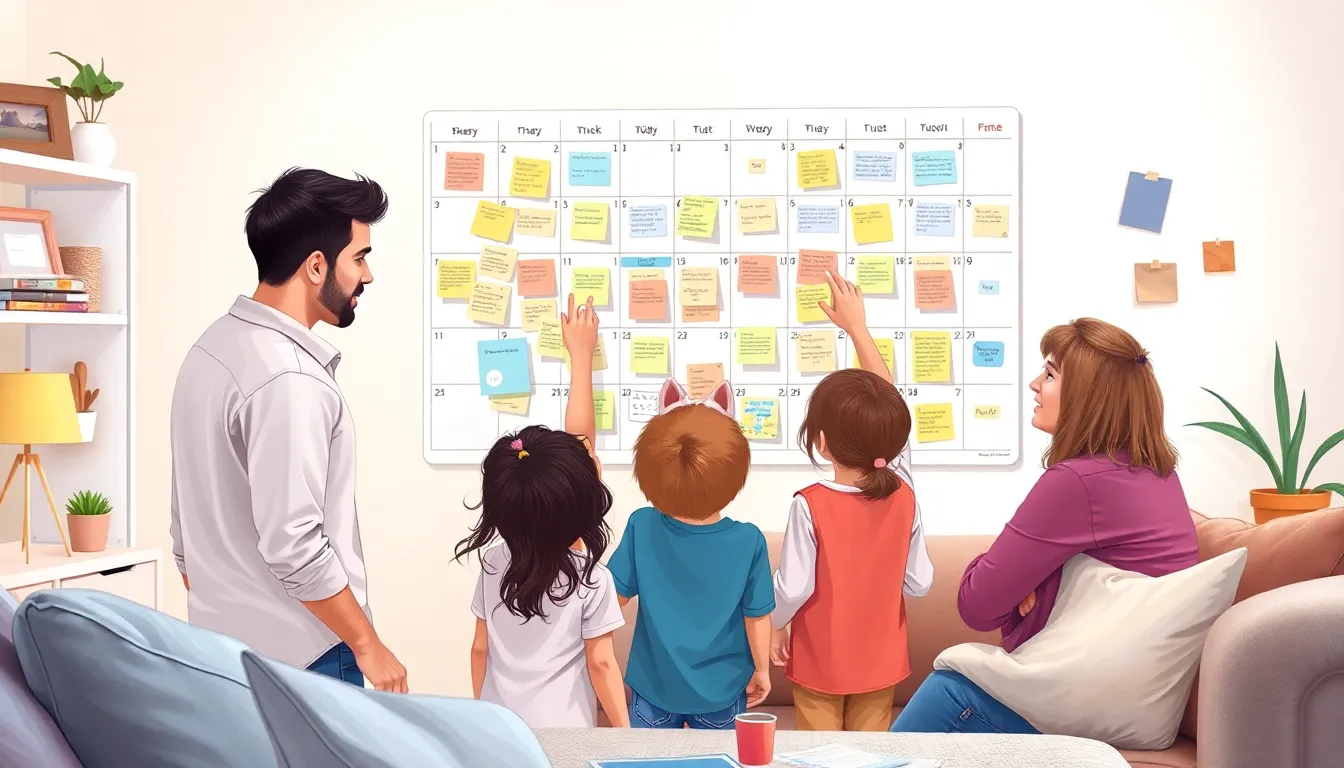In a world where kids are glued to screens and parents are juggling endless responsibilities, finding the right balance can feel like a high-wire act. Enter the structured play routine—a superhero in disguise that swoops in to save the day. It’s not just about keeping the little ones entertained; it’s about fostering creativity, social skills, and a sense of responsibility, all while having a blast.
Imagine a magical schedule where playtime isn’t chaotic but filled with purpose. With a structured play routine, kids can dive into imaginative worlds, build epic forts, or channel their inner Picasso—all while parents sip their coffee in peace. So, let’s explore how this simple yet effective approach can transform playtime from a free-for-all into a delightful adventure that benefits everyone involved.
Table of Contents
ToggleUnderstanding Structured Play Routine
Structured play routines serve as an essential framework for children’s development. These routines foster creativity and help children develop crucial social skills.
Definition and Importance
A structured play routine refers to a consistent schedule of planned activities designed to engage children in play. This approach enhances learning by blending fun with purpose. Structured play not only nurtures imagination but also encourages responsibility. Children thrive within boundaries, as these routines provide predictability and security. Research indicates that children benefit from regular play patterns, leading to improved emotional regulation. Establishing these routines benefits children and grants parents peace of mind, knowing their kids are engaged in enriching experiences.
Key Components
Several key components construct an effective structured play routine. First, variety in activities keeps children’s interest high. Incorporating different types of play, such as physical, creative, and social, engages multiple skills. Scheduling specific times for each type fosters adherence to the routine. Next, an environment tailored to facilitate play ensures safety and accessibility. Including materials that inspire creativity, like art supplies or building blocks, can enhance engaging experiences. Lastly, active participation from parents boosts the value of structured play, as guidance and support during these activities nurture deeper connections.
Benefits of a Structured Play Routine
Structured play routines offer numerous benefits for children, enhancing their development in various ways. These routines not only provide predictability but also foster a sense of security and well-being.
Cognitive Development
Cognitive skills flourish during structured play. Engaging in diverse activities encourages critical thinking and problem-solving. Activities like puzzles or building blocks stimulate creativity and logical reasoning. Participation in role-playing games helps children understand various perspectives and enhances memory retention. Regularly scheduled playtime with educational games supports knowledge acquisition. Improved attention spans and concentration often result from consistent practice in focused play activities.
Social Skills Enhancement
Social skills development thrives within structured play environments. Cooperative activities promote teamwork, teaching children the importance of collaboration. Interactive games encourage effective communication, helping kids express their thoughts and emotions clearly. Sharing toys or taking turns during play helps instill empathy and respect for others. Engaging in group activities provides opportunities to practice conflict resolution and negotiation skills. Long-term friendships often form when children participate in regular, structured play, contributing to their overall emotional intelligence.
Implementing a Structured Play Routine
Establishing a structured play routine requires intentionality and planning. Parents can create an effective environment that promotes engagement while meeting developmental needs.
Strategies for Parents
Prioritizing a consistent schedule enhances children’s expectations around playtime. Organizing a variety of activities ensures that children stay stimulated. Designating specific times for indoor and outdoor play increases children’s physical activity. Incorporating elements like art projects or building challenges encourages creativity. Using timers can help manage transitions between activities, making shifts smoother. Fostering parental involvement in play nurtures strong bonds and enhances children’s experiences.
Tips for Educators
Integrating structured play into the classroom offers significant benefits. Providing diverse activity stations caters to different interests and developmental levels. Encouraging collaborative projects fosters teamwork and communication skills. Implementing daily routines with set play periods creates stability for students. Observing children during play helps educators tailor activities that meet specific needs. Incorporating educational themes into play enhances learning while keeping it enjoyable. Using feedback from children can refine routines to better engage students in future activities.
Common Challenges and Solutions
Structured play routines face challenges that require effective strategies. Addressing these challenges enhances the overall play experience for children.
Addressing Resistance
Children often resist structured play due to a desire for autonomy. Establishing a clear purpose for activities can increase their interest. Parents might involve kids in the planning process, allowing them to choose some activities, which fosters ownership. Setting consistent expectations helps children understand the importance of routine. Positive reinforcement encourages participation; praising their efforts builds confidence. Engaging children through interactive elements, like games with familiar themes, improves their willingness to participate.
Adapting to Different Ages
Each age group presents unique needs within structured play. Younger children benefit from play that emphasizes sensory exploration and motor skill development. Incorporating age-appropriate themes, like animals or vehicles, captures their attention. For older kids, activities should stimulate critical thinking and creativity, such as strategizing in group games. Adapting routines encourages active participation and social skills development among peers. Regular assessments of interests and capabilities ensure activities remain suitable. Tailoring play routines to developmental stages keeps children engaged and nurtures their growth effectively.
Conclusion
Implementing a structured play routine can transform playtime into a valuable experience for both children and parents. This approach not only nurtures creativity and social skills but also instills a sense of responsibility in young ones. By prioritizing intentional planning and variety in activities, parents can create a safe and engaging environment that promotes emotional regulation and cognitive development.
As children explore through play, they build essential skills that extend beyond the playroom. Embracing structured play routines allows families to enjoy meaningful interactions while fostering lifelong friendships and emotional intelligence. With a little effort and creativity, parents can turn everyday play into an enriching journey for their children.






